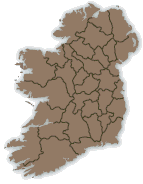An tabharthas a thug Feoras go hOileán Baoi - Mícheál Ó Laoghaire
Recording: [Download audio file]
[Download AIFF audio file (of processed ‘user’ version)]
[Download AIFF audio file (of archive version)]
Transcript
Tá Oileán Baoi ar an dtaobh thiar theas do chalaithe Bhéarra agus d'imigh siad (...) le hiascach. Agus do thógadar (...) lán d'iasc go dtí Neidín chun é dhíol.
Agus ar a ndul thar n-ais dóibh do bhí mada rua ina luí marbh ar an dtráigh mar ba dhóigh leo. Agus do bheir ceann dos na fir ar an mada rua leis an... den eireaball agus do chaith sé isteach sa bhád é mar go gcífidís go raibh sé marbh. "Déanfaidh so caipín maith dhom," ar seisean.
Dh'iomraíodar leo go ndeaghadar abhaile don oileán agus do caitheadh an mada rua amach ar an dtráigh. Agus d'imigh siad suas chun an chnoic leo. Do tháinig (...) (chosa snámha) orthu.
D'imíodar abhaile agus ar maidin ámáireach do bhí leath na ngéitheach agus na lachan agus na gcearca dhá raibh san oileán marbh tairigthe cois clathach agus tríd an gcnoc go ndeaghadar sa chladraigh ar bhruach linn na faille.
Ach nuair a lean na gadhair an mada rua an lá a bhí chútha d'imigh sé agus do bheir sé ar shlait do bhí os cionn na cladraí agus do leog sé é féin síos sa chladraigh leis an slait. Agus do caitheadh na gadhair síos le faill na farraige agus maraíodh a leath.
Do chuadar abhaile agus do niseadar a scéal agus an oíche a bhí chútha do deineadh an léirscrios naofa céanna ar na lachain do bhí fágtha agus ar na géithibh. Agus dúirt seanduine a bhí san oileán é a fhágaint leis féin agus dúirt sé an tslat do ghearradh aigeá[1] bun. Agus nuair a (chloitheadar) an mada rua an lá a bhí chútha do bheir sé ar bharra na slaite agus do cuireadh (in) líontachaibh síos i measc na ngadhar a bhí marbh leis an bhfaill é.
Translation
Dursey Island is to the southwest of the harbour of Kenmare and they went (...) fishing. And they took (...) full of fish to Kenmare to sell.
And when they returned there was a fox lying dead on the beach or so they thought. And one of the men caught the fox with the... by the tail and he threw him into the boat so that they would see that he was dead. "This will make a good cap for me," he said.
They rowed on until they came home to the island and the fox was thrown out onto the beach. And they went off up the hill. (...) came on them.
They went home and the next morning half the geese and ducks and hens that were on the island were dead dragged along walls and through the hill down to the stony beach at the edge of the cliff pool.
But when the dogs followed the fox the next day he went and got hold of a branch that was above the stony beach and he let himself down onto the stony beach with the rod. And the dogs leaped down the sea-cliff and half of them were killed.
They went home and told their story and the coming night the same holy devastation was visited upon the remaining ducks and the geese. And an old man who was on the island said to leave him alone and to cut the bottom of the branch. And when they heard(?) the fox the next day he caught the top of the branch and he fell away from them (?) down the cliff in amongst the dead dogs.
Footnotes
= ag a. Cf. Seán Ua Súilleabháin, 'Gaeilge na Mumhan', in Kim McCone et al. (eag.), Stair na Gaeilge (Maigh Nuad, 1994), 479-538: 504. (Back)Commentary
The fox is one of the most prominent figures in folklore, and this is especially true of international folktales. This story contains the motif k341.2 Thief shams death and steals, in Stith Thompson, Motif-index of folk literature (rev. and enlarged ed., 6 vols, Bloomington, Ind., 1955-8). It appears to be based on an international folktale, namely ATU 1 The theft of fish, in which the fox feigns death and is thrown on a cart from which he steals fish. See Hans Jorg Uther, The types of international folktales: a classification and bibliography (3 vols, Helsinki, 2004). Many Irish examples have been found, distributed all over the country. See Seán Ó Súilleabháin and Rieder Th. Christiansen, The types of the Irish folktale (Helsinki, 1968).
Title in English: The gift that Pierce brought to Dursey Island
Digital version published by: Doegen Records Web Project, Royal Irish Academy
Description of the Recording:
Speaker:
Mícheál
Ó Laoghaire from Co.
Cork
Person who made the recording:
Wilhelm Doegen
Organizer and administrator of the recording scheme: The Royal Irish Academy
In collaboration with: Lautabteilung, Preußische Staatsbibliothek (now Lautarchiv,
Humboldt-Universität zu Berlin)
Recorded on 12-09-1928 at 13:50:00 in Convent
of Mercy, Killarney (office). Recorded on 12-09-1928 at 13:50:00 in Convent
of Mercy, Killarney (office).
Archive recording (ID LA_1078d1, from a shellac disk stored at the
Royal Irish Academy) is 02:10 minutes
long. Archive recording (ID LA_1078d1, from a shellac disk stored at the
Royal Irish Academy) is 02:10 minutes
long.
User recording (ID LA_1078d1, from a shellac disk stored at the Royal
Irish Academy) is 02:08 minutes long. User recording (ID LA_1078d1, from a shellac disk stored at the Royal
Irish Academy) is 02:08 minutes long.





